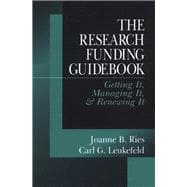
Note: Supplemental materials are not guaranteed with Rental or Used book purchases.
Purchase Benefits
What is included with this book?
| Preface | xi | (2) | |||
| Introduction: Getting It, Managing It, and Renewing It | xiii | ||||
| I. Resubmitting a Not-Funded Application: Issues and Decisions | xiv | (1) | |||
| II. Funded! Practical Issues | xv | (1) | |||
| III. Funded! Welcome to the Small Business World | xvi | (1) | |||
| IV. Continuing a Project by Submitting a Competitive Application | xvii | (1) | |||
| V. Application Preparation | xvii | (1) | |||
| VI. Other Considerations | xviii | ||||
| Part I. Resubmitting a Not-Funded Application: Issues and Decisions | 3 | (56) | |||
|
3 | (16) | |||
|
3 | (2) | |||
|
5 | (1) | |||
|
6 | (1) | |||
|
7 | (4) | |||
|
11 | (3) | |||
|
14 | (1) | |||
|
15 | (4) | |||
|
19 | (16) | |||
|
19 | (1) | |||
|
20 | (1) | |||
|
21 | (3) | |||
|
24 | (7) | |||
|
31 | (1) | |||
|
32 | (1) | |||
|
33 | (2) | |||
|
35 | (24) | |||
|
35 | (1) | |||
|
36 | (1) | |||
|
37 | (1) | |||
|
38 | (2) | |||
|
40 | (5) | |||
|
45 | (1) | |||
|
46 | (13) | |||
| Part II. Funded! Practical Issues | 59 | (34) | |||
|
59 | (16) | |||
|
59 | (1) | |||
|
60 | (11) | |||
|
71 | (1) | |||
|
71 | (1) | |||
|
72 | (3) | |||
|
75 | (18) | |||
|
76 | (1) | |||
|
77 | (3) | |||
|
80 | (1) | |||
|
80 | (1) | |||
|
81 | (1) | |||
|
81 | (2) | |||
|
83 | (1) | |||
|
83 | (1) | |||
|
84 | (1) | |||
|
84 | (1) | |||
|
85 | (1) | |||
|
86 | (1) | |||
|
87 | (1) | |||
|
88 | (5) | |||
| Part III. Funded! Welcome to the Small Business World | 93 | (58) | |||
|
93 | (19) | |||
|
93 | (1) | |||
|
94 | (1) | |||
|
95 | (1) | |||
|
96 | (3) | |||
|
99 | (8) | |||
|
107 | (2) | |||
|
109 | (3) | |||
|
112 | (14) | |||
|
112 | (4) | |||
|
116 | (4) | |||
|
120 | (6) | |||
|
126 | (12) | |||
|
127 | (2) | |||
|
129 | (1) | |||
|
130 | (3) | |||
|
133 | (2) | |||
|
135 | (1) | |||
|
136 | (2) | |||
|
138 | (13) | |||
|
138 | (4) | |||
|
142 | (2) | |||
|
144 | (2) | |||
|
146 | (5) | |||
| Part IV. Continuing a Project by Submitting a Competitive Application | 151 | (20) | |||
|
151 | (11) | |||
|
151 | (1) | |||
|
152 | (3) | |||
|
155 | (2) | |||
|
157 | (1) | |||
|
158 | (1) | |||
|
158 | (4) | |||
|
162 | (9) | |||
|
162 | (2) | |||
|
164 | (1) | |||
|
165 | (1) | |||
|
166 | (5) | |||
| Part V. Application Preparation | 171 | (50) | |||
|
171 | (23) | |||
|
172 | (11) | |||
|
183 | (9) | |||
|
192 | (2) | |||
|
194 | (13) | |||
|
194 | (2) | |||
|
196 | (1) | |||
|
197 | (1) | |||
|
198 | (1) | |||
|
199 | (1) | |||
|
200 | (3) | |||
|
203 | (4) | |||
|
207 | (14) | |||
|
207 | (1) | |||
|
208 | (1) | |||
|
208 | (4) | |||
|
212 | (4) | |||
|
216 | (1) | |||
|
217 | (1) | |||
|
217 | (4) | |||
| Part VI. Other Considerations | 221 | (19) | |||
|
221 | (9) | |||
|
221 | (2) | |||
|
223 | (1) | |||
|
224 | (3) | |||
|
227 | (1) | |||
|
227 | (3) | |||
|
230 | (10) | |||
|
230 | (2) | |||
|
232 | (2) | |||
|
234 | (1) | |||
|
235 | (2) | |||
|
237 | (3) | |||
| References | 240 | (4) | |||
| Index | 244 | (9) | |||
| About the Authors | 253 |
The New copy of this book will include any supplemental materials advertised. Please check the title of the book to determine if it should include any access cards, study guides, lab manuals, CDs, etc.
The Used, Rental and eBook copies of this book are not guaranteed to include any supplemental materials. Typically, only the book itself is included. This is true even if the title states it includes any access cards, study guides, lab manuals, CDs, etc.